| Previous Unloads: | |
|
1991 May: A Visit to Langkawi, the Land of Mahsuri 1991 Aug: Study tour to Medan, Indonesia 1994 May: First Asia Pacific Chitin and Chitosan Symposium (APCCS) 1995 Dec: Revisiting SAS 1997 Dec: Rally Nationwide Vision 1998 Apr MOU and Launching of Chito-Chem (M) Sdn Bhd 1999 Sep: The Officiation of Smart Technology Centre, UKM 1999 Sep 23: A Week on Leave 1999 Dec: Study Tour to Taiwan 2000 Jul: A MiniReunion of Class of 66 2000 Dec: Just An Unlucky Day 2001 Jul: 29th Covocation of UKM 2001 Dec: Digging Deep Into the Root: SKBT Revisited 2002 Sep: A Consequential Events from Feb 2002 |
2003 Apr: Reminiscing the Little Boy 2003 Nov: Reunion of Class of 66 2004 May: Cameron Highland Revisited 2004 Jul: In the Heart of Two Cities 2005 Jan: SAS Re-revisited 2005 Jan: Seri Puteri Eventually Visited 2005 Apr: In the Backyard (and Frontyard) 2005 Nov: Jalan Hale Revisited 2006 May: Kenyir, Here I Come 2006 Jun: Bidong Revisited 2006 Aug: Convocation UKM #34 2006 2006 Oct: The Faces of Ramadan 2007 Mar: Duku - The Fruit of Terengganu 2007 Nov: Ke Tepian Sang Seluang Melaut |
| Ke Tepian Sang Seluang Melaut - Home to Where I Belonged to (Dated: 2007 Nov) |
The journey back "ke tepian" began with a take off in a drizzlly morning at KLIA. Leaving behind the glittering city of Kuala Lumpur, the place I first arrived 1967 Jan 19 Thu evening by a long distance taxi from Kuantan, with buddies to check in Sekolah Alam Alam Shah, Jalan Cheras.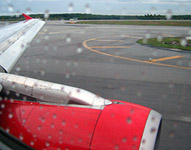  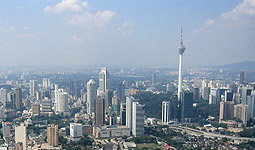 |
The compactness of living. Above the white clouds over the Titiwangsa.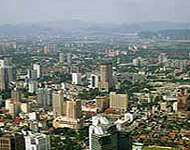 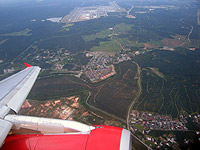 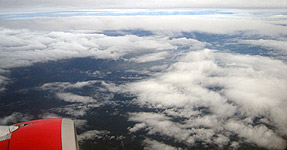 |
In half an hour hop, Terengganu was visible. The Kenyir that borders Pahang and Kelantan, which is part of Taman Negara. The man-made lake that did not exist when I was "a citizen" of Terengganu more than thirty years ago. In a few minutes, the shoreline on which I danced the tango with the pounding waves was on the horizon. Terengganu, here I am, I am coming home. A trunk road much bigger than the original along which I walked or sometimes cycled in the sun-heat or the monsoon-shower, was being built heading half way towards the sea. I believed it is the part of Lebuh Raya Pantai Timur, the Terengganu chapter. Nerus river in which I swam like I was a fish when I was a boy was on the foreground. Even Bidong in the distant background where I fished a lot recently was quietly in the welcoming mood.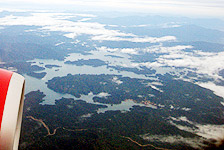 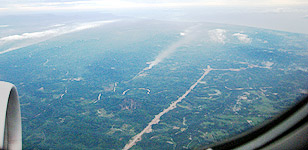 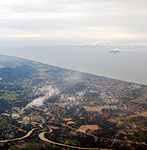 |
The playground when I was a little timid boy was condensed into a picture the size of the aircraft window - with changes soon to be found beyond recognition. The Nerus river with an almost formed horse-shoe island at Tanjung Sabtu. The Buluh Gading Bridge which was built when I was about eight years old, together with Manir Bridge. My birth place Pengkalan Arang is at the lower tip of the river. The Batu 6 roundabout. The road into the "forest" where I began my taste of the acid and alkali of life. The Sultan Mahmud Airport from where I never stopped amazing the flying machine when I saw it taking off. And every place from Tanjung Gelam to Merang on the shoreline where I was taken by my parents to visit the relatives and to grow up to become one of them. The aircraft toured the sea before landing to view all the beach life from Telaga Batin to the tip of Merang beach. Every one in every place along the beach knew my father because he carpentered many houses in many places along the beach. A few fishing boats were seen rushing towards the open sea. Perhaps a few of them were my distant relatives. And perhaps my return today coincided with a good catches. 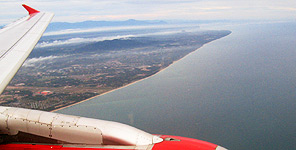 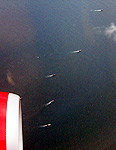 |
Landed. Sultan Mahmud Airport. For the first time viewing the terminal from this POV at this close. During the turbofan-fokker time, the airport was known simply as "Telaga Batin" airport. I came here several times to amaze myself when seeing the flying machine touch down or take off, which then was not an every day event to see. And later seeing the relatives going or arriving. The airport was by the beach, but I never ended "the visit" to the beach because many of my relatives lived by the more beautiful and lively beach.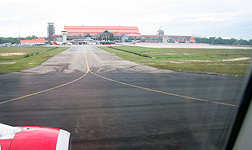 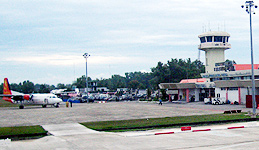 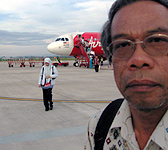 |
Arrived. The exact home and place where I was born fifty six years ago, and grew up in the vicinity for twelve years before I left for distant schools and became a hostel boarder. It was duku season, and the tree behind the house, aged slightly older than myself, planted by my father, was the first to welcome me with its irresistable fruits - just on time for picking. And blossoming infront was the "kenanga", the flower my mother liked very much to the end of her life. And brought home by my sister on the day was some tampoi fruit, or locally "ngeké", the favourite fruit my father used to surprise us on his return from a few days "outstation" carpentering.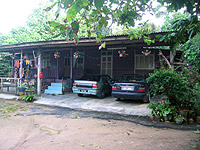 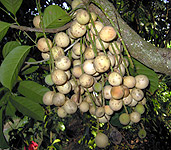 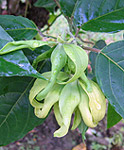 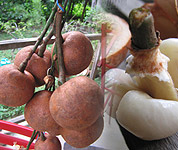 |
Strolling around the home. The coconut trees, the oldest are older than the elders from whom I learned to grow up. Some were just slightly higher than PakNgah's "bangsal nyadat" in which he made the coconut sugar from which PakNgah always gave me the privilage to have the residue (kerak nisan). And the even higher "nibong", the pack of which was there high obove other trees as far as I could remember, the "pelepah" of which that fall to the ground my father turned into pails whenever needed to draw water from the well. The jambu mawar which is the grand-sibling of the one when I was a little boy, the fruit of which were part of my "life", were left fallen on the ground, unattracted to todays children - blinded away from its nutritious goodness. The 'chengal' beside the cemetary was a baby when I was a little boy on which I learned how to climbed. Now quite a grown up, and is being groomed for a timber. 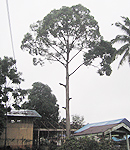 |
The then implicit Jalan Pengkalan Arang from Buluh Gading bridge. It was just a cleared pathways, for "footers", and cyclists. Occasionally, four-wheelers went through to deliver materials, which became a source of "entertainment show" to the children - frequently running behind the wading four-wheeler, "escourting" to its destination. Perhaps, a car once a year. Unfit entirely during monsoon which appeared more like a swamp than a "road". Lining along the roads were dispersed houses, full of various trees, fruiting types and equally otherwise. The tall "pinang", the fat "piah", bushes of non specific use, even to goats, the place for chirping birds, some "salak" near china Tan ex-place where they made "roti paung", and the graveyard where my father (1972 Mac 18 Sat) and my mother (1989 Sep 14 Thu) were laid to rest. Now, a tarmac, as anywhere else, even though very narrow. Cleared and full of dwelling places. Many are "new comers", unfamiliar with the place in the old days. Making me a total "stranger". |
The "gate" to the river Nerus at the Pengkalan Arang. A large part of the land belonged to the late PekTam Mezah, whose son Ripin (a carpenter staying in Tok Jiring) is my growing-up-mate, just like the neighbouring Musa (a broiler farmer staying in Banggol Katong). In recent times, very late in his life, he let the pengkalan part to LKIM to build its "dry dock". Many fishing boats, and several maritime vehicles come to this dock for repair. That was after the river was no longer a place for growing-up children to make themselves up. The river bank at that particular part where we used to wash ourselves, our dresses, the place to fetch the water for the kitchen, the place to watch the flood come and go, the place for the boys and girls to enjoy the water-life, now out of bound. |
The fanny palas, the apetizing foliage of putat, the purple senduduk, the abrassive mempelas, the rosy kemunting, and the webby ara are there. They are growing well and healthy, and seemingly untouched as of the time I left.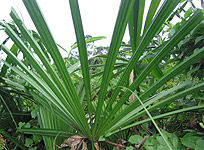   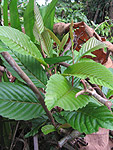 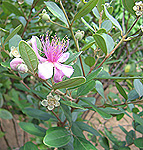 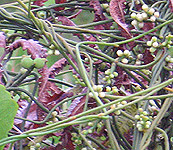 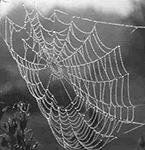 I knew though that they are the great-great grandsibling of those who were part of my life fifty years ago. I'd love to see the fauna too. The dragonfly, the grasshopper, the little marsh frog, the "keridik", the pipit, the mynah, and the silvery spider web sprayed by the morning dew. |
An evening to a beyond Pak Katak where my grandfather had built a foot-bridge for the farmers surrounding its vicinity to reach their "sawah". The bridge was named "Titian Haji Ahmad", and his sawah was along it. I had sometimes when I was a little boy helping my father to grow padi there. From preparing the "sawah" to carrying the padi harvested back home. On the shoulder as well as on bicycle. The place dislocated from my locus when I became a hostel boarder in 1964. As of today, the bridge was marked into the reserve for the road. So, in a few years time, Titian Haji Ahmad would become a tarmac road passable by motorised vehicle including cars. The titian would be "preserved" if the road is named "Jalan Haji Ahmad".
|
It used to be padi in its season and nothing else on both side of the bridge because the sawah was deep. The fishes of black puyu, haruan, keli, sepat, selat, karin, sekila, and the fat leeches, and the small creatures, flying and hopping, and jumping. It actually joined Pak Katak and Gong Kijang, a place as wild as the "forest". Pak Chan who stayed at end of the titian was a good friend of my father. He lived by making coconut sugar. His "presence" currently is through his son Pak 'Id who lived at the same vicinity. |
The "ubiquitous" Batu 6, the centre of my playground, and the "gate" from where I began the taste of acid and alkali of life. Including my mother at the end of her life. None of those sitting or standing "guarding" their cookies were friends of my mother. They are young and I believed only a few knew the history of the place. Some of my buddies were still around, seen sporadically among the crowd of "strangers". Some survived among the traders in the market, selling fish or fruits. All the shop operators are "foreigners".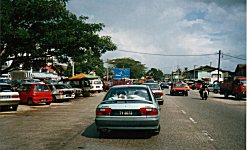 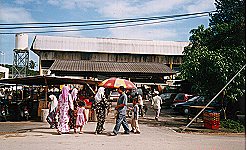 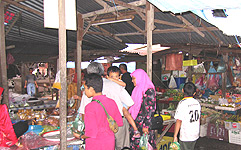 |
Even though the fish section does not appear new, other dry sections are seen tremendously upgraded. A quick "scan" however did not show the kind and the look and the feel I used to in the old days when Batu 6 market was known for many delicacies. I felt that I won't be missing anything if I don't come here often. |
The only original "kedai china" left is that of Kiat who had moved from around the roundabout to near the Forest Station when the road widening excercise swallowed his (and other chinas) den. The rest of the chinas who survived by their sibling, have migrated, in conceding to the more "authentic" chinas whose number now become significant. Kedai Hock (middle pic below) is dying; his siblings had moved somewhere else. Hock and his wife, Sa Chin. Rumah Keng (right pic below) remained a dwelling place but their siblings are not known to inherit his business of selling fabric to make dress. We knew one son Pemo, and the smallest Chan who is sometimes around the house.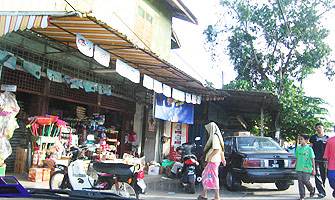 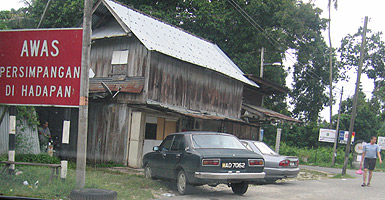 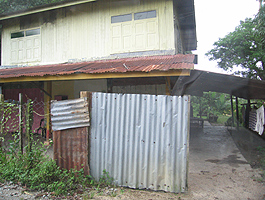 More kedai china are so noticeable, and much bigger. Even as "supermarkets", and "departmental stores" owner. Like elsewhere, they cannot even speak melayu, far more from speaking "terengganu". Unlike Kiat, Tiong, Hock, China Panjang, Keng, China Tan and Kepala Besar, whose only difference from the rest of the locals were that they did not go to the mosque in the afternoon on Friday for the prayer. At one time they all have a similar high passion for cock fighting. Kiat died many years ago, suffering from a strange fit after an inter-kampung games of "gasing" which he never missed to participate, as much as in "lumba perahu" (rowing boat racing). He had a daughter who is a UKM-graduated-KPLI-MPI teacher, became a muslim and married to a fellow teacher. Kiat was very furious about that and vowed to "kill" her. But he never seriously searched for her. Kiat's wife is known as Mek Kiat, who is now running the grocery, and when she was young was a good seamstress that many local learned from her. She eventually learned herself how to make "baju kurung", but short of "baju melayu" (male formal dress). Kiat and Hock knew my family very well, but not their siblings. Kiat went for his daughter's registration in UKM Bangi in late 1980's, and stumbled with me at PUSANIKA. Kiat was so "local" that he explicitly expressed his aweness when "unexpectedly" seeing so many chinese in UKM on the registration day. The whereabout or the fate of the rest of the chinas are not well narrated. |
 Ramadan 1428 set in Sep 13 Thu. But not much of the old days the fun of Ramadan. And not much of the old days cookies too. This one, "pulut lepe" was perhaps the last "pedigree". Now at 25 sen each, the size was halved. Against the 10 sen each before. Meaning five times since then. Not too bad actually compared to others, especially the fish. The equivalent in KL is called "pulut panggang", but the filler was "inedible" since it is made from prawn and chillied coconut. The "pulut lepe" filler is made from fish mixes. It gained quite a petronage that some took it independently out of market stall into the road side, just like the "lemang". Perhaps "pulut lepe" is the only authentic icon left around to remember the good old days. Ramadan 1428 set in Sep 13 Thu. But not much of the old days the fun of Ramadan. And not much of the old days cookies too. This one, "pulut lepe" was perhaps the last "pedigree". Now at 25 sen each, the size was halved. Against the 10 sen each before. Meaning five times since then. Not too bad actually compared to others, especially the fish. The equivalent in KL is called "pulut panggang", but the filler was "inedible" since it is made from prawn and chillied coconut. The "pulut lepe" filler is made from fish mixes. It gained quite a petronage that some took it independently out of market stall into the road side, just like the "lemang". Perhaps "pulut lepe" is the only authentic icon left around to remember the good old days. |
Cabang Tiga was another market place, used to be bigger than Batu 6. It was at the gate of Kuala Terengganu from the north and west. This place was not my playground. In the old days I was taken here only once or perhaps twice, by the sibling of TokChik when we visited them at Hiliran Jejawi. Since it was "accessible" by small fishing boats, the market served the sea-foods to "barter" with the land produces of the southern side of Terengganu river hinterland, the equivalent function of Manir market for the northern side of the river (during the time Buluh Gading and Manir bridges did not exist). Currently, it is said that the price at Chabang Tiga market is cheaper than that at Batu 6. |
Manir. In the old days, Manir market was a weekly market. On Saturday morning only. It was the marketplace for the Manir hinterland. All were land produce, including "land" fish. To date, it operates every day including Friday from the morning to whenever just like every other markets. In the vicinity, it was known to market produces and cookies of more traditional items. |
I was attracted to the boiled "jering", the boiled "perah fruit", and the "rambai". The rest were the similar items as found in Batu 6, Gong Badak, and Tanjung. All are new and "modern" contemporary dishes. When I was a little boy, jering was the specialty of MokTehChoh who lived down "balik hulu". Another one of hers was boiled "keladi baruh". Boiling jering needed not just a skill, but also a correct ingredients and procedure, otherwise the jenkolic acid in it would not get removed. Eating such jering then caused the acid to precipitate in the urinery bladder which will take the sufferer to the hell of pain. "Buah perah" is the edible fruit the cousin of rubber plant. The giant trees grow in the wild especially in Pahang, the fruits were collected by the aborigines and so on their way to the market. My eldest cousin who lived in Kuala Sentul used to trade this fruit during one of his career. "Rambai" is the undomesticated variety of its family duku-langsat. At times it became more expensive than even the Terengganu duku. It is the only member that the fruit skin could be turned into a delicacy dish on the table. |
I passed by my alma mater, SK Bukit Tunggal 1958 Jan - 1963 Aug. It had changed beyond recognition, especially after my "recent" revisit in 2001 Dis 20. It thus pointless to poke inside to see my past shadows. But the shop infront of the gate which sold selected items like sweets affordable to the pupils is still standing. Perhaps after some "upgrading", became a motor workshop. As I circled the compound, I noticed the old head master house at the foot of the then Bukit Tunggal is still standing, refurbished, still on stilt, and appeared like being dwelled. The HM that I knew were staying there in the 1960's was CheGu Tengku Muda. |
 The "back road" that used to be the front road, 2007 Oct 31 Tue 0715. Not many boys and girls were seen going to the school. There were actually, but taken by parents in cars. Unlike in the old days, around this clock, this road was full of pupils walking towards the school. The once trunk road K.Trg - Kota Bharu from Losong Ferry. The sharp bend at the foot of Bukit Tunggal was made safer, less bend and thus less tilting. The changes on the right side of the road are beyond recognition. The "ghostly" hill of Bukit Tunggal had disappeared. The site is now a flat land very ready for building the dwelling structures. In not too distant future, no one will believe that once upon a time their residency site was a scary and "ghostly" hill. The "back road" that used to be the front road, 2007 Oct 31 Tue 0715. Not many boys and girls were seen going to the school. There were actually, but taken by parents in cars. Unlike in the old days, around this clock, this road was full of pupils walking towards the school. The once trunk road K.Trg - Kota Bharu from Losong Ferry. The sharp bend at the foot of Bukit Tunggal was made safer, less bend and thus less tilting. The changes on the right side of the road are beyond recognition. The "ghostly" hill of Bukit Tunggal had disappeared. The site is now a flat land very ready for building the dwelling structures. In not too distant future, no one will believe that once upon a time their residency site was a scary and "ghostly" hill. |
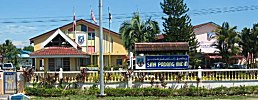 My other alma mater which I had not have a chance to revisit is the "Sekolah Menengah Padang Midin" which is out of my current locus. It is eight km on the way to Kuala Berang. To the west of K. Terengganu. My last visit was 1973 Aug 19 Sun on Persatuan Mahasiswa Sains UKM ticket to give a talk in the hall on pre-science (precursor to UKM Matriculation) to school pupils with Abdul Rahman and Kaida Khalid (both were my juniors) - the same talk I gave in SMK Kolam Air, Kuala Lumpur, 1973 Jul 15 Sun, with Sukiman Sarmani. I boarded the school from 1964 Oct to 1966 Jan, before I went to Sekolah Alam Shah, Kuala Lumpur with the Sijil Rendah Pelajaran cert. My other alma mater which I had not have a chance to revisit is the "Sekolah Menengah Padang Midin" which is out of my current locus. It is eight km on the way to Kuala Berang. To the west of K. Terengganu. My last visit was 1973 Aug 19 Sun on Persatuan Mahasiswa Sains UKM ticket to give a talk in the hall on pre-science (precursor to UKM Matriculation) to school pupils with Abdul Rahman and Kaida Khalid (both were my juniors) - the same talk I gave in SMK Kolam Air, Kuala Lumpur, 1973 Jul 15 Sun, with Sukiman Sarmani. I boarded the school from 1964 Oct to 1966 Jan, before I went to Sekolah Alam Shah, Kuala Lumpur with the Sijil Rendah Pelajaran cert. |
 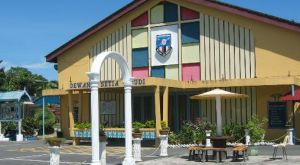 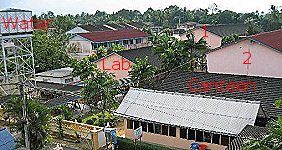 |
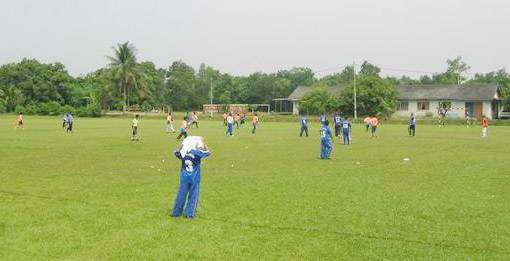 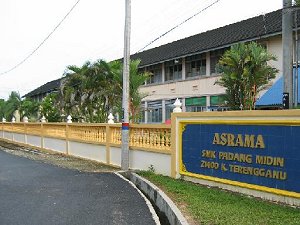 |
Wakaf Padang through the then "forest". A place in the middle of the "forest" from Batu 6 to Kubang Badak, the shorter way to the beach. Every "traveller" on foot or on bicycle stopped here to quench, or even to pray. There was a shelter hut beside a very tall "sepetir", visible from a distance away. The bamboo-grass among the sparsely short bushes beautified the vicinity. A typical arid land features. There was a deep well for the travellers to fetch the water. People just passed through here, not even to gather cashew. Life as wild as tiger was said to roam here. Wild boars were ubiquitous. No one was brave enough to pass this place at night.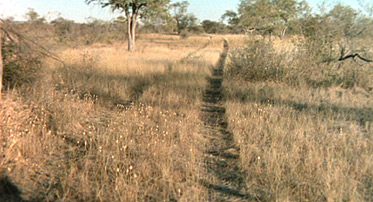 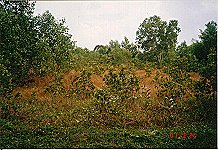  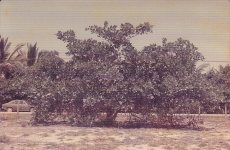 |
My sense spotted this bend as the then Wakaf Padang. It is now swarmed with people, many are the young ones who dwell the UDM's KUSZA campus, and the next-door UMT. It was no longer a scary place. It is very alive day-time and night-time with all sorts of human activities. The activity of "forest gathering" by the vicinity locals had already been classified as "tale". |
Kubang Badak and the adjacent Pak Tuyu along once the only road connecting Batu Rakit and Seberang Takir that passes Tok Jembal and Telaga Batin Airport, was my father favourite spot for a break on his way to or from the "pantai". The place was more "friendly" than Wakaf Padang because it was nearer to the dwelling places of Tok Jembal and Tanjung Gelam. The place was cooler, full of short gelams and "wet" by many clear water streams. Sometimes my father and I had "shower", and then pray. At night, the place for some (because majority of them took only sea fish) became the fishing grounds for "keli pulut" and "keli panjang". My father favourite spot disappeared to give away to the state of the art development. The place is now blessed unprecedentedly any where in the country. The road was widened and was lined by the wall-fence of two Universities. Universiti Darul Iman Malaysia (UDM) KUSZA campus (ex-Kolej Ugama Sultan Zainal Abidin), and Universiti Malaysia Terengganu (UMT - ex-KUSTEM, ex-KUT, ex-UPMT); a million miles away from the acclaimed "intelectual city" of Bangi in Selangor and Nilai, Negeri Sembilan. The whole area from Kubang Badak to Wakaf Baru is now known as "Gong Badak", beginning at UDM - KUSZA; then "Wakaf Tembusu" to Batu 6. UMT adopted the address of "Mengabang Telipot", the parent district of Kubang Badak. |
Saddling in the Universiti Darul Iman Malaysia (UDM), City Campus, Jalan Sultan Mahmud, Kuala Terengganu. Teaching chemistry for the Food Technology Programme in the Faculty of Agriculture and Biotechnology. A cool and breezy place, a place where I was unsderstood that I was expected eventually. They even told me that I was "introduced" even before I reported myself for duty. Understandably, the saddle would not last that long.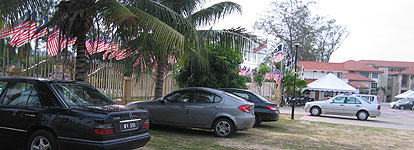 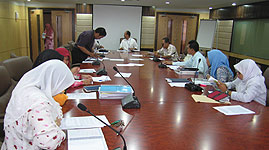 |
This is all the Faculty of Agriculture and Biotechnology, the elements of which made the world was getting smaller and smaller each day passed. |
Pulau Kambing, a corner shop, now with a traffic light. This shop used to make a very famous bread in Kuala Terengganu, known then as "roti pulau kambing", and was priced ca. 20% higher than the "normal bread". When my brother began his trial of life in early 1960's, he used to sell this bread in area of Paya Datu, especially during Ramadan. One afternoon, he fell ill after coming home from getting the stock. My mother asked me to take them to his route to prevent it from unsold. The bun was priced 15 sen for two pieces. At one home in Jalan Paya Datu, a young man wanted to buy only one piece. And he made me departed for 7 sen because I could not return his half sen if he pay 8 sen. The half sen coin did not exist any more during that time. 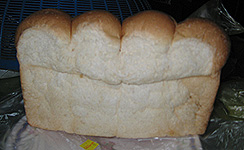 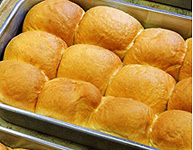 |
Bas Station, Kuala Terengganu in 1960's, at Jalan Masjid. Terengganu Bus Company was the major transport operator with the yellow busses. To Kota Bharu, it was the blue buses of the North East Transport Service (NETS), and To Kemaman, the maroon Tong Aik express buses, and to Kuantan the blue K.Trg-Kuantan Express. The toilet from which the catch-name "jamban stesen bas" originated. |
 |
The rest of it. A line of ticketing offices for the express busses next to the waiting two rows of wooden seats, covered, which in turn next to eateries which served a good breakfast and lunch menus of "nasi malaya" [the served dishes were called "nasi padang"]. I never eat here because I could not afford it. I normally used this place to rendezvous with friends, or sometimes simply waiting for any friends. This whole section currently is a bookshop which to my view is more of a stationary. The cover which harboured the buses, loading or unloading passengers. The buses to Jertih, Batu Rakit, Dungun (the furthest), Marang, Kuala Berang, Wakaf Tapai and a few more short distances. The first two passed along my place and were our transport to and from town. |
Opposite side of the road of the bus station was the Merdeka Agency. Perhaps this was the first departmental store then. In 1966, I bought, by asking my dorm-mate Mohamad Sulaiman, a white T-shirt "Rider", and a long sleeve white shirt "KOOL" which became my best dress in 1966, and on to SAS in 1967. But whenever I "congregated" with friends in town, especially Othman and Omar, I ended up at the "gerai" in front of the Cathay cinema, in Jalan Jail for ten-sen ABC. I have never been to the cinema of either in the Cathay or the Rex behind the bus station. Opposite Jalan Jail was the Badminton Hall and the office of Mergastua (wild life), which had given away to the current bus terminal. |
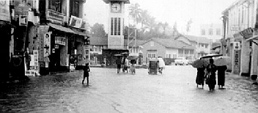 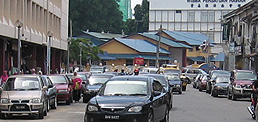 Kedai Payang with its street bended at a right angle from Jalan Banggol, thus equally a commercial street. The street was more associated with "PakLah Yunan", who then owned a bookshop, but more of religious nature. In the late 1990's, it had a slice of the school textbooks handling. The roundabout tower clock had eventually been removed after a decade of hard fight to preserve it. Kedai Payang with its street bended at a right angle from Jalan Banggol, thus equally a commercial street. The street was more associated with "PakLah Yunan", who then owned a bookshop, but more of religious nature. In the late 1990's, it had a slice of the school textbooks handling. The roundabout tower clock had eventually been removed after a decade of hard fight to preserve it. |
Jalan Banggol, right from Kedai Payang, then left at the Kampong China junction, which was preserved to this date, including their names. From this junction, on the left, I made my first long pant trouser, in 1966. For sometimes it was the only non-school uniform long pant I had, even when I was in Sekolah Alam Shah, Kuala Lumpur. Its successor was in 1970. I had my first myopic eye-glass 1967 Saturday April 8 I made at the Lim Optical in Jalan Masjid. |
Jalan Banggol was the "commercial street" of Kuala Terengganu. At its end at Jalan Paya Bunga on the right building, first floor, was the "Pustaka Timur", the only bookstore in Kuala Terengganu. In 1964 Feb, I came to this bookstore to collect my textbooks loaned by the Welfare Department. When I received my FMS in Mar, I bought myself all the textbooks, and returned the loan books. Opposite Putaka Timur was a small stationery shops from where I bought a set of two ringgit "adjustable" rubber stamp, a 'toy' no other students knew its existence at the time. I regretted later for the waste I made although it stamped my name on every book I bought. I took it to Sekolah Alam Shah, Kuala Lumpur and it ended there. The site of Pustaka Timur is currently Bank Islam. I never knew what happened to it, or where it moved, and died. From Pustaka Timur I first learned "Dewan Bahasa dan Pustaka", the institution I later became "part" of it from 1980's. |
 Jalan Sultan Omar was then a small "back" road and implicitly called "Jalan Titian Lembut". It was widened to give more access to Gong Kapas. I passed this road now twice or three times a day to-and-fro office. Apart from the "daun pisang", Jalan Sultan Omar now hosted the gate to the then famous elite school Sultan Sulaiman Primary which then addressed as per Jalan Batas Baru which could not be accomodated for the swelling school vicinity. I could have myself be to the school in 1961 after the SMC exam, like my two classmates Ismail and Ambak. But it was logistically impossible then to arrive at this school at half past seven from my home, irrespective of the SMC results. And had I made myself through, I might have succumbed to the inability to transform from "sekolah melayu" to "english school" which then charted a completely different destiny. Jalan Batas Baru, Jalan Sultan Omar, and its associated Jalan Cerong Lanjut were "foreign" to me. I went to the school only once, not sure the time, in the school cheering football team which took part in a certain sport festival. Jalan Sultan Omar was then a small "back" road and implicitly called "Jalan Titian Lembut". It was widened to give more access to Gong Kapas. I passed this road now twice or three times a day to-and-fro office. Apart from the "daun pisang", Jalan Sultan Omar now hosted the gate to the then famous elite school Sultan Sulaiman Primary which then addressed as per Jalan Batas Baru which could not be accomodated for the swelling school vicinity. I could have myself be to the school in 1961 after the SMC exam, like my two classmates Ismail and Ambak. But it was logistically impossible then to arrive at this school at half past seven from my home, irrespective of the SMC results. And had I made myself through, I might have succumbed to the inability to transform from "sekolah melayu" to "english school" which then charted a completely different destiny. Jalan Batas Baru, Jalan Sultan Omar, and its associated Jalan Cerong Lanjut were "foreign" to me. I went to the school only once, not sure the time, in the school cheering football team which took part in a certain sport festival. |
Jalan Paya Bunga was the downtown of Kuala Terengganu. It was renamed Jalan Sultan Ismail, from Kedai Binjai to Ladang junction. From Kedai Binjai, on the right is the Hoover Hotel, the only hotel in the old Kuala Terengganu, apart from several "Rumah Tumpangan" around Kampong China. The the only bank, HSBC. The the District and Land Office, from where I "chased" for the DO signature in 1967 Jan to complete the acceptance forms to go to Sekolah Alam Shah, Kuala Lumpur. In this office in 1971 Feb, I made my first passport as advised by MARA in anticipation to go to Australia. Then the Jalan Air Jernih, known for its Terengganu Dental Hospital. Then a few shops lots, then Jalan Batas Baru, known for its elite school the english Sultan Sulaiman Primary School. Then the police HQ up to the Jalan Sultan Omar junction. |
The changes on the left side of Jalan Paya Bunga from Kedai Binjai to Ladang were equally "catastrophic". It opened up to Jalan Banggol, then Jalan Masjid, Jalan Tok Lam. Then the stadium, around which are the Wisma Darul Iman which housed the Chief Minister Office, Wisma Negeri, and Wisma Persekutuan, which are best viewed from Jln Sultan Omar, or on receding Ladang. In the old Kuala Terengganu in this section were the government departments. One was the National Registration office where my mother took me to, to make my IC in 1963. The only "old" landmark is the diused Rex cinema at the Jln Masjid junction, opposite the Wisma MPKT.
|
Kedai Binjai which apart from being a marketplace, was the parking lot for Pulau Duyung inhabitants. The in early 1980's the market place died of natural death when Kedai Payang was upgraded, and it changed to long distance taxi stand. Now it became Sri Malaysia. And along river Terengganu to Balik Bukit and, Pulau Kambing. The street off Pulau Kambing which is successfully branded for the produce of the most Terengganu authentic, keropok, Losong.
|
Tanjung in the old days was an harbour. The Terengganu Shahbandar was the harbour guardian. The river mouth was an "oceanlet". The ocean wind was used to drive the passenger sailing boats commuting to Seberang Takir. And during monsoon time, the water was scary choppy, and shuttle sailing across Kedai Payang - Seberang Takir was many times deferred. In 1960's I used to dip my feet in the mud at the water margin in the swarming of "belukang" fish, getting down from the boat from Pengkalan Arang, shouldering a bagful of rice husk (dedak) to be sold to the retailer MekNab at the market. My brother and I sort of traded the "merchandise". We purchased the "dedak" at the rice mills in the hinterland at 20 sen per gantang, searching on bicycle as far as Kebor. Packed four gantangs in a flour guni. When two gunis were full (1.60 rm cost), we took it to Tanjung by boat with 20 sen passage to-and-pro. At Tanjung, the retailer took it at 40 sen per gantang, making the turn over 3.20 rm. Substracting the 20 sen transportation cost and 20 sen meal, my brother and I made 1.20 rm each in a trip to Tajung, which we made twice a week. Unfortunately the business lasted for a few weeks only. We were just tasting the acid and alkali of life, the kind that my brother continued when I left to board the hostels.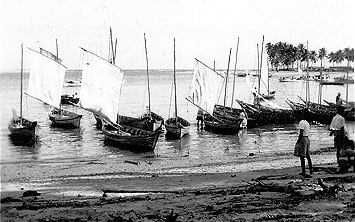  |
Tanjung, once a big market place. Now a makeshift market of the kind "pasar malam", and "pasar ramadan", plus one shopping "complex" Astaka. Much of the land was actually reclaimed. The monsoon causes the current to dig the Tanjung side and dumps on the Seberang Takir side, constricting the river mouth smaller and smaller. |
Tanjung at this time of the year is a Pasar Ramadan. Other times it is just a parking bay for express bus to certain destinations. People come here for the shopping place Astaka. |
 Seberang Takir, Padang Malaya, Tajung, where I grew up would become a memory. In newer generation memories, the place would become be very different, even though it is at the same place. Seberang Takir, Padang Malaya, Tajung, where I grew up would become a memory. In newer generation memories, the place would become be very different, even though it is at the same place. |
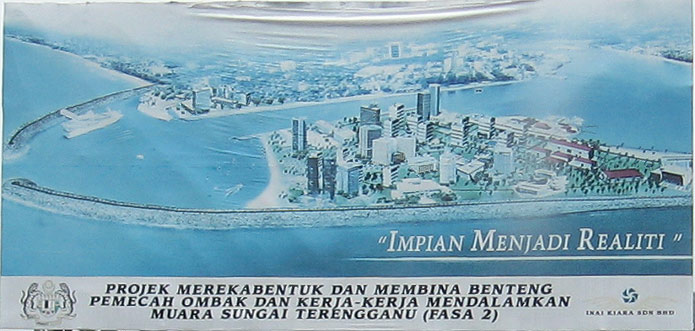 |
Tanjung from Padang Shahbandar to where now is the Astaka, once was the biggest market place in Kuala Terengganu. Nearly everything was available. Now it a leisure park, very shadowy and windy facing the sea breeze. In the old days, padang Shahbandar was just a wide blank space the people used to do anything, including rendezvousing. For that it was known as "Padang Malaya". [Adj "malaya" means "mixed" as in "nasi malaya" - mixed menus in one plate, and "kayu malaya" - mixtures of types of timber]. Padang Malaya was really full of people during festival time in Padang Maziah. |
Tanjung, viewing towards Masjid Putih. From left, the durable MARA building from which in Sep 1974 I bought a bagful of various batik dresses to be taken to England when I went there for for postgraduate course. The Jalan Masjid, then the Padang Maziah and its associate Terengganu installation palace of Istana Maziah. On this "padang" joining the "Padang Malaya" in the 1960's, annual festivals were held during the installation celebration. A rare source of entertainment of traditional play like "rodat", "mokyong", "dikir barat", "wayang kulit", etc for the "rakyat jelata". I remembered I was here once only, but could not picture out with whom. But it was with many adults, travelling by boat from Pengkalan Arang. Then the Post Office. Then the Bukit Puteri where celeberation guns of "Navarone" were kept and fired, especially during Ramadan and Shawal. Then the Kedai Payang, which is the one left, maintained and
"upgraded" of the three "kedai"s in the old Kuala Terengganu. There are still some remnant "teksi" of the old days, which was actually trishaws. One of which was owned by my mother's uncle PokLleran who stopped riding it when the earning from it became impossible to feed his children. |
The Post Office, apart from beautification upgrading, it is original opposite the Padang Malaya (the Shahbandar). In this post office in 1964 Mar I opened a POSV account for the FMS I recieved. It was at the counter #1 and #2, then grilled, and aligned in line with other counters. It was continued to KL when I was in SAS, and then in UKM, and correspondingly transformed when it was taken over by BSN in 1974 Dec. To then it was a vehicle in my lifeline especially during my SDOR engagement with RTM Rangakaian Nasional. When I began my tutorship in the second half of 1974, BBMB was engaged in nearby UM, but I kept the dear BSN ex-POSV account to 2007 Apr 6 Fri when I closed it, two weeks before my retirement, in BSN Bandar Baru Bangi branch, after very close to forty three years. |
Cherong Lanjut is the extension of Jalan Air Jernih from Jalan Paya Bunga. Perhaps this was my least-familiar place in KT in the old days, public transport into it was very rare. It depended entirely on trishaws ride. In the 1960's this place was even scarsely inhabited. I did not just pass this place, but been there twice during my school days. The "target" was the Grammar School, which is a private school ticking strongly from 1960's to these days. One in 1966 when I was in Form 3 in SM Padang Midin, for a "speaking contest", did not know who organised it. CheGu Halim picked me up (recommended by Wan muda Mamat - a form fiver, supposedly Malay Language Society), first a hit at Grammar School, then a final in the Hall of Sultan Zainal Abidin Secondary School, Batu Buruk. I was given the title "Tempat Jatuh Lagi Dikenang, Inikan Pula Tempat Bermain", and CheGu Halim fed me with what to say. I was bad compared to the arabic-trained speakers; nonetheless, everyone was given something to take back to the school, in my case a consolation prize, a novel "Di Bawah Lindungan Kaabah" by Hamka. The school catered for rich pupils who did not make in the exam, of which some parents hid it by saying that "his son or daughter has bored studying in government school and wanted to study in private school".
Again in late 1968, or sometimes before mid 1969 I strolled on bicycle with Othman Ngah to this school with Othman's idea in mind to apply for the job of a temporary teacher while waiting for the SPM results to come out. We actually went to see the owner who initially welcome us warmly thinking that we were his new potential pupils. But as soon as we stated our purpose of visit, he instantly apologised for no vacancy. Othman and I then had our own adventure before we re-checked in Sekolah Alam Shah, Kuala Lumpur for our form six, 1969 Apr 21 Mon. The vicinity is now "opened" as an access to the Padang Hiliran development, including the approach to the Duyung Bridge by a newly built road Jalan Kemajuan after crossing the Jalan Bukit Kecil. In the scarcity of the dwelling old wooden houses, Jabatan Kimia Malaysia (Chem Dept) Cawangan Timur was built along Jalan Cherong Lanjut, the TNB HQ, and an access gate to Sultan Sulaiman Primary School, immediately before the road joins Jln Sultan Omar. Jln Cherong Lanjut hosts the only hindu temple in Kuala Terengganu. |
Ladang was a cool suburb of Kuala Terengganu. Extended from Tanjung, it has more coconut trees than the dwelling places. The Tanjung sea breeze could still be felt in Ladang in the 1960's. Access road to the Masjid Putih was upraded and named Jalan Sultan Sulaiman. The big cemetary on the left from Ladang to Jalan Paya Bunga is still there, with Jalan Pusara running perpendicular to it. My teacher CheGu Saadiah stayed here when I was her pupil in schools in Terengganu. Some relics are still visible though. During our "naughty" years in the secondary school, Ladang was "London", as Manir was "Munich", Marang was "Madrid", Setiu was "Seattle", Besut was "Beirut", Jeram was "Jerman", and Losong was "Lisbon". That pretty form 3 girl was a "Portuguese". |
The beach of Batu Buruk, left to the north, and right to the south. Similar beach up to Merang, the beach my mother enjoyed the nature when she was a baby and a child. "Batu buruk" is seen transgressing the Kapas island, to which I went for the first time, 1968 or 1969, in a rodeo of riding the wave in a fishing boat to be shown my half sea-goer blood. "Batu Buruk" is the stony "offshoremark" for the beach, as is the "Batu Rakit". A distance away to the south was the safety wall of the hostel of Sultan Sulaiman Secondary School. The first hostel I boarded, 1964 Jan. Further up was the lagoon of Kuala Ibai where sometimes I sneaked in to enjoy chasing the wind blown spiky grass-ball in between the baby mangroove, not knowing that it was against the hostel regulation. In the lagoon I had my very first picture, with a few buddies. |
 The beach end of the boys hostel of Sultan Sulaiman Secondary School where I started my hostel life in 1964 Jan. The wall-fence, which probably had been renewed several times by now. The beach which appeared unvisited. Unseen in this picture is the close wave tongue that sometimes licking close to the wall. For nine months, I stayed in the dorm, ground floor of the block on the left (A-Block) with the warden CheGu Ghani. The middle Block is the B-Block with the warden CheGu Nava. Between the blocks was the dining hall in which for the first time, every night I got a green apple. Apparently there is a new block, the left one which did not exist in my time. And the ru trees which I think are the same one that wheezed by the monsoon wind with a melody that carved irreversibly permanent in my memory. The beach end of the boys hostel of Sultan Sulaiman Secondary School where I started my hostel life in 1964 Jan. The wall-fence, which probably had been renewed several times by now. The beach which appeared unvisited. Unseen in this picture is the close wave tongue that sometimes licking close to the wall. For nine months, I stayed in the dorm, ground floor of the block on the left (A-Block) with the warden CheGu Ghani. The middle Block is the B-Block with the warden CheGu Nava. Between the blocks was the dining hall in which for the first time, every night I got a green apple. Apparently there is a new block, the left one which did not exist in my time. And the ru trees which I think are the same one that wheezed by the monsoon wind with a melody that carved irreversibly permanent in my memory. |
Very tame waves skimming the surface of lifeless watermargin. Relics of a very rich life in the past. |
On the flat land against the beach, a jamboree of all-Terengganu boys scouts was held, one Saturday 1963 mid. I was in the contigent for Sekolah Kebangsaan Bukit Tunggal. It was under the ru trees with the leaves wheezing to the blow of the sea breeze. And some tents too. And that night it gave my mother a frenzy hell of sleepless night because I did not return home even after it was dark. It was logistically impossible for me to reach home after six, the time the jamboree shouted "hape, hape, hoorey" three times. Instead I had an anecdote with CheGu Ismail, the in-charge scout master. |
Jalan Batu Buruk which was renamed Jalan Sultan Mahmud. This was the elite dwelling area of Kuala Terengganu. Lining the road were the quarters of high level state personnels, the residence Istana Badariah and other "smaller" palaces, the official residence of the Chief Minister, the elite schools Sultan Sulaiman Secondary School (SSSS) and Sultan Zainal Abidin religious school, the state general hospital. The riches dwelled along this road. This was one and only "run way" for the "flight" to Kuantan, and on to the "distant" Kuala Lumpur. It was precisely on this "runway" that I took off 1967 Jan 19 Thu morning in K.Trg-Kuantan express bus with several buddies to Sekolah Alam Shah, Jalan Cheras, Kuala Lumpur. A long forty years return "flight" cruising my destiny. I was always a "seluang" after all. I should rightly be destined to return to "tepian", eventually. Kuala Terengganu is still a peaceful place to stay to continue to live. But in an accelerated development, this would not be long. |

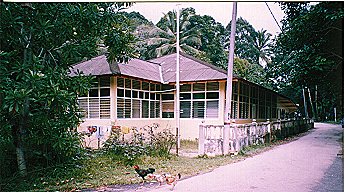
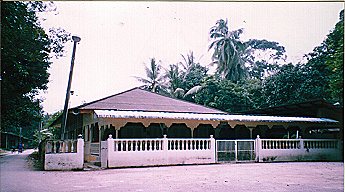
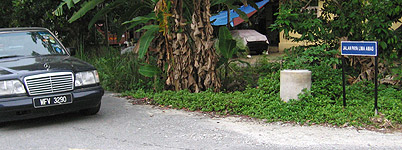
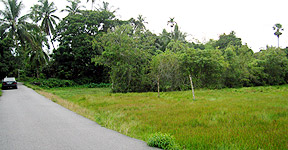

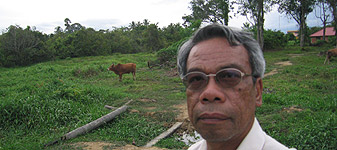
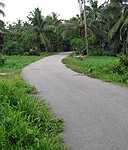
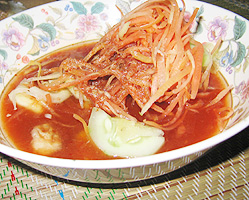 Titian Lima Amas had an associated atrribution of "rojok betik". At the end of the foot-bridge, in a tight high edge row fence of hibiscus there were MakLong and PokLong who as far as I could remember made "rojok betik", every day except Friday, and sell it at Batu 6 market even since the market was in "Banggol". MokLong and rojok were interchangeable. When my mother took me with her to the market, rojok was my choice of snack. A small 5 sen plate with two pieces of fried "keropok" was more than finger-licking good. I don't remember a day rojok was not made because MokLong was ill, until the day MokLong passed on, then PokLong. Unfortunately the "rojok betik" at the end of the "titian lima amas" was not inherited. Rojak betik is easy to make, but very difficult to attain "delicacy". Perhaps the very personal of "the nail juice" of a certain person made a cookie a delicacy or just a mixture of cooking ingrediaents. To make rojok betik, first the mature betik (papaya), the one just about to ripe, is cut into halves. The seeds are removed. The "meat" is dessicated (using a specially made tool) into noodle size strands. Other fruits could be added to impart better "biting" taste. More frequently cucumber and pineaple. The sauce (which is the trade-mark) is made from ground dried red chilly, simmered with coconut vinegar (artificial vinegar will spoil everything), protein-sweetened with ground grilled fish (of sardine type), and further sweetened with coconut sugar (never cane sugar). Water is added for correct viscosity, and salt added to taste.
Titian Lima Amas had an associated atrribution of "rojok betik". At the end of the foot-bridge, in a tight high edge row fence of hibiscus there were MakLong and PokLong who as far as I could remember made "rojok betik", every day except Friday, and sell it at Batu 6 market even since the market was in "Banggol". MokLong and rojok were interchangeable. When my mother took me with her to the market, rojok was my choice of snack. A small 5 sen plate with two pieces of fried "keropok" was more than finger-licking good. I don't remember a day rojok was not made because MokLong was ill, until the day MokLong passed on, then PokLong. Unfortunately the "rojok betik" at the end of the "titian lima amas" was not inherited. Rojak betik is easy to make, but very difficult to attain "delicacy". Perhaps the very personal of "the nail juice" of a certain person made a cookie a delicacy or just a mixture of cooking ingrediaents. To make rojok betik, first the mature betik (papaya), the one just about to ripe, is cut into halves. The seeds are removed. The "meat" is dessicated (using a specially made tool) into noodle size strands. Other fruits could be added to impart better "biting" taste. More frequently cucumber and pineaple. The sauce (which is the trade-mark) is made from ground dried red chilly, simmered with coconut vinegar (artificial vinegar will spoil everything), protein-sweetened with ground grilled fish (of sardine type), and further sweetened with coconut sugar (never cane sugar). Water is added for correct viscosity, and salt added to taste.